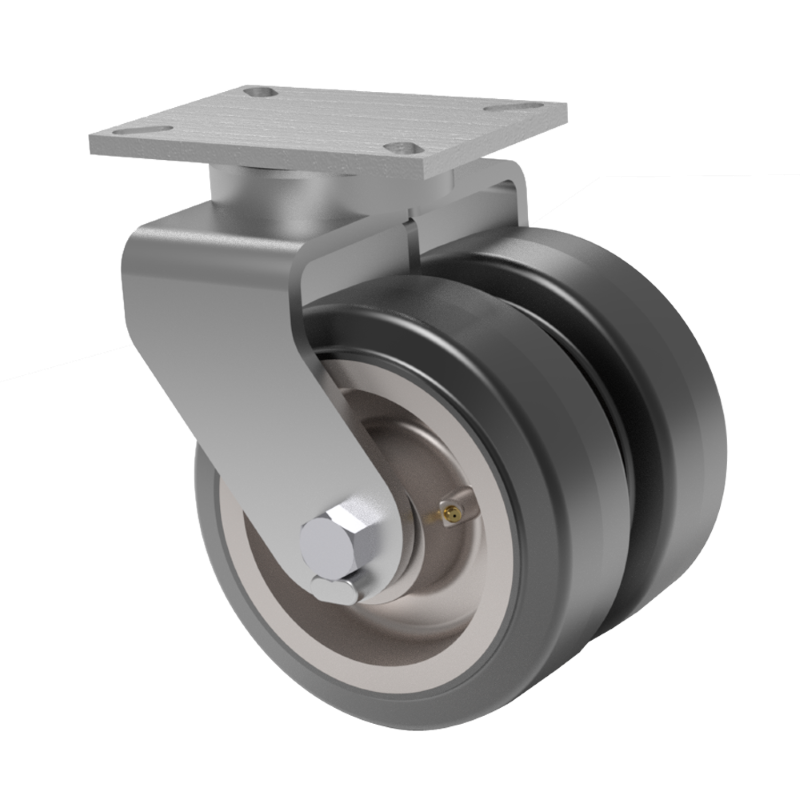The Ultimate Guide to Dual Wheel Casters: Everything You Need to Know
When it comes to moving heavy loads, the choice of casters can significantly impact efficiency, safety, and overall performance. Among the various types of casters available, Dual Wheel Casters have emerged as a versatile and powerful solution for a wide range of applications. Whether you are in manufacturing, healthcare, logistics, or any other industry that requires the movement of heavy equipment or materials, understanding the benefits and applications of dual wheel casters can help you make informed decisions.
What Are Dual Wheel Casters?
Dual Wheel Casters are a specialized type of caster that features two wheels mounted on a single top plate. Unlike single-wheel casters, which rely on one wheel to bear the entire load, dual wheel casters distribute the weight across two wheels. This design offers several unique advantages, making them ideal for a wide range of applications.
The key components of dual wheel casters include the wheels, top plate, axle, swivel head, and brake mechanism. The wheels come in various materials such as polyurethane, rubber, or steel, each offering different benefits depending on the application. The top plate connects the caster to the equipment, while the axle holds the wheels in place. The swivel head allows the wheels to rotate 360 degrees, providing excellent maneuverability, and the brake mechanism ensures that the equipment can be securely locked in place when needed.
Advantages of Dual Wheel Casters
Higher Load Capacity
One of the primary benefits of Dual Wheel Casters is their higher load capacity. By having two wheels share the load, these casters can support significantly more weight than single-wheel casters. For example, two wheels rated at 2500 kg each can together support a total load of 5000 kg. This makes dual wheel casters ideal for heavy-duty applications such as moving large machinery, transporting heavy materials, or supporting industrial equipment.
Improved Stability and Lower Center of Gravity
Dual wheel casters provide improved stability and a lower center of gravity. The dual-wheel design distributes the weight more evenly across the two wheels, reducing the risk of tipping or uneven load distribution. Additionally, the use of smaller diameter wheels allows for a lower overall height of the equipment. This lower center of gravity enhances stability and safety, especially when moving heavy loads.
Enhanced Maneuverability
Enhanced maneuverability is another significant benefit of dual wheel casters. The dual-wheel design reduces the pressure on each wheel, making it easier to swivel and change direction. This is particularly useful in environments where space is limited, and frequent changes in direction are necessary. The reduced friction and “floor scrubbing” also mean that less force is required to move the equipment, improving ergonomics and reducing the risk of workplace injuries.
Floor Protection
Floor protection is an important consideration in many facilities, and dual wheel casters can help minimize floor damage. By distributing the weight more evenly across a larger surface area, these casters reduce the risk of scratches or indentations on the floor. Additionally, the use of softer materials like polyurethane for the wheels can further protect delicate flooring.
Durability and Longevity
Durability and longevity are also key advantages of dual wheel casters. Designed to withstand heavy use and harsh conditions, these casters are made from high-grade materials such as steel or durable plastics. The dual-wheel design reduces wear and tear on each individual wheel, resulting in a longer lifespan for the caster. This means fewer replacements and lower maintenance costs over time.
Applications of Dual Wheel Casters
Industrial Manufacturing
In industrial manufacturing, dual wheel casters are indispensable for moving heavy machinery, equipment, and materials. The high load capacity and durability of dual wheel casters make them suitable for the demanding conditions of industrial environments. They are used in assembly lines, warehouses, and manufacturing plants to transport large components and finished products.
Healthcare
The healthcare industry relies on dual wheel casters for a variety of applications. Hospital beds, surgical tables, and medical equipment carts often use dual wheel casters to ensure smooth and stable movement. The ability to distribute weight evenly and provide a lower center of gravity is crucial in maintaining patient safety and comfort. Additionally, the use of non-marking wheels helps protect hospital floors from damage.
Logistics and Warehousing
Logistics and warehousing operations benefit from the efficiency and maneuverability of dual wheel casters. Pallet trucks, forklifts, and material handling equipment often incorporate dual wheel casters to move heavy loads quickly and easily. The reduced friction and improved stability allow for smoother operations, reducing the risk of accidents and injuries.
Aerospace and Automotive
The aerospace and automotive industries require precision and reliability in their material handling solutions. Dual wheel casters are used in these sectors to move large components and assemblies. Their high load capacity and durability make them suitable for the rigorous demands of these industries. Additionally, the ability to maintain a low profile while supporting heavy loads is essential in these applications.
Furniture and Equipment Moving
In the furniture and equipment moving industry, dual wheel casters are used to move heavy items such as large appliances, office furniture, and industrial equipment. The dual-wheel design allows for easier maneuvering and better weight distribution, reducing the risk of damage to both the items being moved and the floors.
Choosing the Right Dual Wheel Casters
Key Considerations
Selecting the appropriate dual wheel casters for your specific needs involves considering several key factors. The first and foremost consideration is the weight of the load you need to move. Ensure that the dual wheel casters you choose have a load capacity that exceeds the maximum weight you expect to handle. It’s also a good idea to factor in any additional weight that may be added in the future to avoid overloading the casters.
Wheel Material
The material of the wheels is another important factor. Different materials offer different benefits. Polyurethane is known for its durability and floor protection properties, making it a popular choice for dual wheel casters. Rubber wheels offer good shock absorption and floor protection and are suitable for environments where noise reduction is important. Steel wheels are the most durable option for extremely heavy loads and rugged environments but can be harsh on floors and may require additional floor protection.
Wheel Diameter
The diameter of the wheels affects the overall height of the equipment and its maneuverability. Smaller diameter wheels allow for a lower profile, which is beneficial in environments with height restrictions. However, larger diameter wheels can handle rougher terrain and provide a smoother ride.
Swivel vs. Rigid Casters
Consider whether you need swivel casters or rigid casters. Swivel casters allow for 360-degree rotation, providing excellent maneuverability. Rigid casters, on the other hand, move in a straight line and are more stable. Many applications use a combination of both types to achieve the best balance of stability and maneuverability.
Braking Mechanism
If you need to secure the equipment in place during use or storage, a braking mechanism is essential. Dual wheel casters often come with built-in brakes that can be engaged to prevent movement. Ensure that the braking mechanism is easy to use and reliable.
Environmental Conditions
Finally, think about the environment in which the casters will be used. Will they be exposed to moisture, chemicals, or extreme temperatures? Choosing casters that are resistant to these conditions will ensure their longevity and performance.
Maintenance and Care for Dual Wheel Casters
Best Practices
Proper maintenance is crucial to ensure the longevity and performance of your dual wheel casters. Regular inspection is essential to identify any signs of wear and tear. Check the wheels for cracks or deformations and ensure that the axle and swivel head are functioning smoothly. Look for any loose bolts or parts that may need tightening.
Cleaning and Lubrication
Keeping your casters clean is also important to prevent the buildup of dirt and debris. Regular cleaning can help extend the life of the wheels and other components. Use a soft brush or cloth to remove dust and dirt. For more stubborn dirt, a mild detergent and water can be used, but ensure that the casters are dried thoroughly afterward.
Lubrication of the moving parts is essential to ensure smooth operation. Use a high-quality lubricant suitable for the type of caster and the environment in which it is used. Avoid over-lubrication, as this can attract dirt and debris.
Timely Replacement
If you notice any parts that are worn out or damaged, replace them promptly. Using damaged casters can lead to reduced performance and safety hazards. Regular maintenance and timely replacement of parts will ensure that your dual wheel casters continue to perform at their best.
Conclusion of Dual Wheel Casters
Dual Wheel Casters offer a versatile and powerful solution for moving heavy loads in a variety of industries. Their high load capacity, improved stability, enhanced maneuverability, floor protection, and durability make them a preferred choice for many applications. By carefully considering the factors involved in selecting the right dual wheel casters and maintaining them properly, you can ensure efficient and safe operations in your workplace.
Whether you are in manufacturing, healthcare, logistics, aerospace, or any other industry, dual wheel casters can significantly enhance your material handling capabilities. With their numerous advantages and wide range of applications, dual wheel casters are an investment that can pay off in increased efficiency, reduced labor costs, and improved workplace safety.





